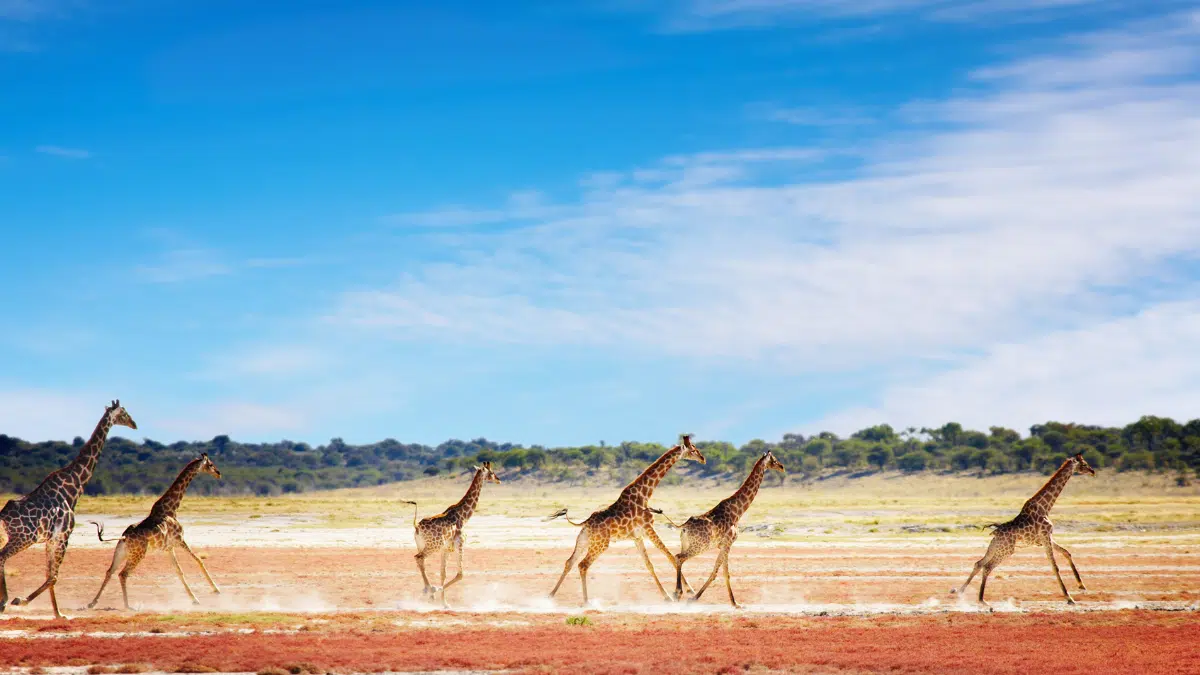Best Time to Visit Etosha National Park (Seasonal Breakdown)
Etosha is one of the most well-known parks in Namibia, and it’s also one of the largest. If you’re planning a visit, you might be wondering, when is the best time to visit Etosha National Park?
The park covers an area that ranges from semi-arid savannah to almost desert conditions. It is home to a number of animals including cheetahs, leopards, lions, elephants, rhinos and zebras among others.
It has beautiful scenery year round. But there are some times when visitors will have a better chance than others of seeing wildlife or experiencing the beauty of nature in this park!
Not only does the scenery and wildlife viewing change, but cost and availability of accommodations in the park are affected by the time of year as well. In addition, crowds are larger on the roads and at the waterholes during some parts of the year than others.
To learn more about the best time to visit Etosha National Park in Namibia read on below.

Winter In Etosha National Park
The best time to visit Etosha National Park in Namibia is during the winter months, from May to October. This is known as the dry season, when it is highly unlikely that you’ll see any rain and can bask in glorious temperatures.
It is this heat that dries up the salt pan and watering holes, which in turn encourages all of the wildlife out on the hunt for new water sources. Once a healthy watering hole is located, copious amounts of wild animals gather around to drink, graze, and bathe.
This creates the most magnificent panorama of mammals and birds, all coexisting in relative harmony. This includes zebras, springboks, and elephants as well as lions! The plethora of animals draws crowds of visitors this time of year.
Everyone wants to see the astounding wildlife!
Many people would think that this park might be an ideal place for viewing animals during freezing dawn hours. The assumption is that this is when they come out to drink water from a watering hole.
However, it turns out that seeing these creatures mid-morning may offer better views. This is actually when they will congregate around water holes in large herds due to their need for hydration.
The reason behind this unusual behaviour is simple: it’s too hot for predators to hunt during the day. Water sources being so central in the dry season, predator and prey alike must drink from the same places.
During such times, plains herds come down to watering holes when their chances against potential hunters are at its lowest point. During these moments where there won’t be as many other animals around either.
The vegetation becomes sparse during the winter months. The chances of seeing many species of animals in the low grass is greatly increased as a result.
It is during this time that there are fewer daylight hours, only about 9 on average. This means that catching the spectacular ‘Golden Hours’ of sunrise and sunset is easy!
No safari would be the same without seeing and photographing the wildlife with the backdrop of the most impressive sunset that Namibia has to offer. The pan itself looks spectacular at this time of the year.
It becomes this huge expanse of white that lends itself to the most amazing photographs. However, don’t be fooled into thinking that this is the only time of year that you should visit Namibia. Summer has plenty to offer if you don’t mind taking your chances with the rain.
Summertime in Etosha National Park
The summer months cover November to April, otherwise known as the rainy or wet season. By no means should this put you off. Any rain that does fall tends to do so in the afternoon and doesn’t last all day.
It is a magical sight, seeing the salt pan fill and the grasslands and vegetation so lush and green. And if you’re a keen birdwatcher then you will be in your element!
Many species of wetland birds migrate from the north to enjoy the riches of food the climate offers. The scenery becomes tinged with pink when flamingos descend. They wade in the shallows along with the storks.
Etosha National Park is home to 340 breeds of bird. A third of those are migratory and arrive during the wet season. As there are fewer visitors at this time of year, the park will be quieter and so will the camp. You might even find that admission prices are reduced too.
These are the busiest times for the wildlife in Etosha National Park. The plains animals like springbok, zebra and wildebeest give birth during this season. The young are weaned only when there will be plenty of food available.
These animals know what’s coming next. At such a bustling time with many activities going on, it is also prime mating season. You can see males vying for females, male animals fighting over females.
As well, and many birds come out to feed on insects at ground level where most grasslands occur due to quick growth rates after rainfall.
The pan itself looks spectacular at this time of the year. It becomes this huge expanse of white that lends itself to the most amazing photographs. The pans become a beautiful location for landscape photographers.
In the early spring, after the first rainstorms have subsided and before summer heat has taken over, Etosha transforms from an arid wasteland to lush emerald green heaven!
The animals there look so much more picturesque when surrounded by this verdant backdrop of greenery. Such a contrast to their usual stark white surroundings during the dry season.
It’s also easier to spot wildlife at these times because they’re not hiding as often in bushes or trees. This is due to predators being less plentiful with all that vegetation around them.
It makes sense why many species give birth just then too – it provides excellent camouflage protection for young ones who are vulnerable. This is important until they can learn how best to protect themselves against hungry felines.

Shoulder Season in Etosha National Park
While summer and winter are both amazing times to visit Etosha, they aren’t your only options. There are two shoulder seasons that you should consider, too. These at the beginning and end of the wet season, or summer.
When it comes to weather, as well as cost and availability, April and November can offer you the best of two worlds. Fewer people are visiting the park at these times, making it easier to find a place to stay with little advance notice.
You are also more likely to have areas of the park to yourself.
In April temperatures are beginning to cool nicely, especially at night. At the same time the park is still green and gorgeous after the wet season. Prices are only just beginning to rise, too, in anticipation of the peak season, so there may still be some bargains to be had.
Take advantage of lower accommodation rates to stay in more upscale lodges, extend your trip, or just save some money! In addition, availability is still high, and you might be able to find openings for accommodations and game drives with little advance notice.
Similarly, November offers lower prices, more availability, and fewer people. November is just the beginning of the wet season, so while the weather may be a bit rainy, the temperature is only beginning to rise.
Mornings and evenings are still relatively cool, the crowds have thinned, and the trees and bushes are just starting to leaf out. This makes for really great wildlife spotting!

Tips for Visiting Etosha National Park
• If you decide to journey to Etosha in the winter, remember that this is peak season in the park. Be sure to book your accommodations well in advance.
• Winter temperatures can dip below 10ºC at night and in the morning. Be sure to bring warm clothes, especially if you plan to go on morning game drives in the park’s open safari vehicles.
• Summer temperatures average 27ºC during the day, but can top 30ºC. Pack loose, cool clothing so you’ll be comfortable.
• Summer rains tend to happen in the afternoons. It’s a good idea to bring a light rain jacket if you’d rather not get wet.
• Binoculars are recommended! They are a great way to be sure that you don’t miss a thing.
• Whenever you decide to visit, don’t forget your hat, sunglasses, and sunscreen, plus insect repellent for those pesky mosquitoes.
Finally – the best time to visit Etosha National Park
Etosha park is open throughout the year. The timing of your visit determines the weather conditions, landscapes, and wildlife that you will experience. The best time to visit Etosha National Park is anytime!
The park is open all year round, and whilst the dry season encourages most wildlife out to play, the rainy season shouldn’t be ignored. You will be able to bask in hotter temperatures, spot many new species of wetland birds that migrate to Etosha.
And if you’re really lucky, you might just get to see some new parents, tending their young!
If you hope to see the maximum amount of wildlife on the game reserve, go in the dry season. But take a few sweaters, the afternoon heat can cool leaving the night air quite chilly.

Carley Rojas Avila is a bilingual New York-based travel writer, editor, content marketer, and the founder of the digital travel publications Explorers Away and Home to Havana. Carley is an expert on all things Latin America, the Caribbean, and Cuba, having lived and worked in four different countries in the region. Her writing has appeared on the Associated Press wires and in Travel + Leisure, Yahoo, MSN, Euronews, The Weather Channel, and more. When she's not writing about her travels, find her front row at a Bad Bunny concert, befriending street cats, and taste-testing every pizza in Havana.

